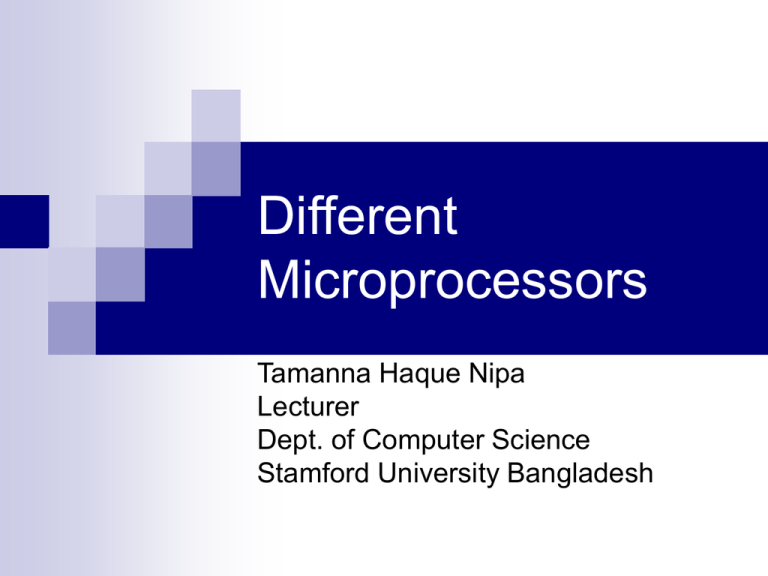IMPACT OF INTER-CARRIER INTERFERENCE (ICI) ON MIMO
advertisement

Different Microprocessors Tamanna Haque Nipa Lecturer Dept. of Computer Science Stamford University Bangladesh Difference between 8086 &8088 External Data Path: 8 bit for 8088 and 16 bit for 8086 Memory Access: 8088 access memory in byte while 8086 can access memory both bytes and words. 8086 has faster clock rate and better performance then 8088. 8088 is less expensive than 8086. 80186/80188 Enhanced version of 8086/8088 The 6/8 MHz clock provides 2 times greater throughput than the 5MHz 8086/8088. 68 pin package On chip priority interrupt controller chip to provide 5 interrupt pins 1 megabyte of memory can be addressed Instructions set as 8086 and 10 new instructions (extended instruction set) 8086/8088 General Registers ALU 16 bit data or operand request Control Segment Register Bus Interface Prefetcher Prefetch Instruction Instruction Decoder Prefetch queue 20 bit address bus multiplexed with data bus 8086/8088 2 units: Execution unit Bus interface unit Both units are independent and operates parallel to each other to maximized th performance. Execution unit It executes all instructions as well as manipulating the general registers and the status and control flags. It sends data and address to the BIU when required Instructions are fed to EU over 8 bit wide prefetch queue bus Instructions are processed by the control system ALU, registers and internal data path are 16 bits wide Bus Interface Unit The BIU processes all requestes from the EU to read data from or write data to memory or I/O device All requests pass through to BIU and it combines the segment and offsets to form the physical address using a dedicated hardware adder Prefetch queue is a small FIFO RAM array, used to prefetch instruction following the current executing instruction for EU when the BIU is free Bus Interface Unit Prefetch queue in 8088 hold 4 bytes and BIU begins a fetch cycle whenever one or more bytes empty in the queue. Prefetch queue in 8086 hold 6 bytes and BIU begins a fetch cycle whenever one or more bytes empty in the queue. When an instruction causes program control to be transferred to the non-sequential location then the prefetch instruction no longer be valid. Then BIU flushes the prefetch queue and immediately starts an instruction fetch at the target address. Features of 80286 24-bit address bus. 16 bit data bus Able to address 16 MB of physical memory. It has a MMU[memory management unit] 68 pins 6 times faster than 8086 Used for multiuser and multitasking 80286 It operates in 2 modes Real address mode: behaves like 8086 and program for 8086 can run directly. Protected virtual address mode: it supports maltitasking, so several program runs at the same time and memory protection is required to protect the memory used by one program from the action of other program Can address 16 megabye of physical address in protected mode and 1 GB of virtual memory. Features of 80286 cont… Register organization of 80286 Eight 16-bit general purpose registers Four 16-bit segment registers Status & control registers Instruction pointer Address unit 80286 Execution Unit General Registers ALU Physical Address Generator 16 bit offsets and data Segment Registers Segment Descriptor Cache Instruction Decoder Decoded instruction Bus Interface Address bus 24 bits Prefetcher Operand request Control Physical address (24 bits) Decoded Instruction Queue Instruction Unit Prefetch Queue BIU Data bus 16 bits Processing Unit 4 Processing Unit Address unit Bus unit Instruction unit Execution unit All units are independent and operates asynchronously and in parallel with the others. Execution unit Execution unit manipulates the general register as well as the status and control flags and executes all instructions. The ALU performs the arithmetic and logical operations that are required by the instruction. ALU also maintain the CPU status and control flags. General registers are used to moves data to or from the registers as required. BUS Interface Unit It handles all communications and data transfer between CPU and the system bus. It generates the address, commands and data signals required to access memory and I/O devices. Data and address bus are not multiplexed. The BIU uses the idle bus cycles to prefetch instructions BUS Interface Unit cont… Pre-fetch queue is 6 bytes long and whenever 2 or more bytes of pre-fetch queue becomes empty the pre-fetch cycle occurs. A control transfer instruction causes the BIU flush the queue and immediately begin loading the instruction from the new address. The Instruction Unit It decodes the pre-fetched instruction bytes for execution unit. Up to 3 fully decoded instructions are available in the queue provided by the instruction unit. The Address Unit In real mode the address unit works same as in the 8086. segment and offset values are summed together by a dedicated adder to produce a physical memory address. In protected mode, every memory references, including code pre-fetches, must be checked against the permissions and segment limits of the current task to detect memory protection violations. After the permission, the logical address needs to translate to a physical address for use by the BIU. A cache has been designed into the address unit named segment descriptor cache register. The Address Unit One segment descriptor cache register is provided for each of the four segment register. When a segment register is loaded with a new value, the segment descriptor specifying access right, segment base address and address size associated with that value is automatically loaded into the appropriate segment descriptor cache register. segment descriptor cache register is only accessed by the address unit. 80386 Similar to 80286 but enhanced 6 parts: BIU Code Prefetch Unit Instruction Decode unit Execution Unit Segmentation Paging Unit Unit Six level of pipelining makes it more faster Each part can work independently and parallel to each other. So different part can process different instruction at a time. 80386 Segmentation Unit Paging Unit Segment register Translation Lookaside buffer Effective address 32 bits Segment Descriptor Cache Execution Unit Protection test unit General Registers Barrel shifter Segment translator Page translator Address bus Physical address Linear address BIU Operand request ALU Multiply/Divide Control Decoded instruction Instruction Decode Unit Instruction decoder Decoded Instruction Queue Prefetcher Prefetch Queue Code prefetch unit Data bus Additional hardware The performance of 80386 has been also improved by some additional hardware 64 bit barrel shifter: a specialized hardware that performs multiple bit shifts in a single clock cycle. 3 input adder dedicated to effective address processing An early-out multiplier : terminates the multiply algorithm when no significant digits remain to be processed. 386DX and 386SX Difference between 80386DX and 80386SX is the width of the external address and data buses. Internally both uses 32 bit pathways. The address bus of 386DX is 32 bits wide and can directly address 4 gigabytes (232 bytes) of physical memory The address bus of 386SX is 24 bits wide and can directly address 16 Mb (224 bytes) of physical memory Bus Interface Unit All requests for access to the bus that comes from the other on chip processing unit passes through the BIU Because of the parallel operation of other parts of the microprocessor, it is possible that more than one bus request may be received by the BIU at the same time BIU also queue and prioritize these requests. To avoid the delaying program execution, request from EU have highest priority Every unit can independently communicate with BIU. The Code Pre-fetch Unit Operates same as 80286 80386 can store 16 bytes of prefetch instrution The instruction decode unit 3 decoded instruction can be saved in decoded instruction queue Same as 80286 Execution Unit The function of the EU can be divided into 3 major parts: Control unit: the function of control unit is to speed up certain types of operations including multiplies, divides and effective address calculations. Data unit: it contains ALU and eight 32 bit general registers of the 80386. it includes 64 bit barrel shifter and an early out multiplier. The protection test unit: it monitors memory to detect segmentation violations. Segmentation unit It performs the first stage of address translation, converting the logical address to linear address. Segment descriptor caches are employed both to speed up the translation and to allow protection violations to be detected without performance. The dedicated 3 input adder is also used to speed up The paging unit It translate the linear address to physical address. If paging unit is not enable then physical address is the same as linear address . It contains a cache called translation lookaside buffer (TLB), which holds 32 most recently used page table entries. 80486 Microprocessor The 32-bit 80486 is the next evolutionary step up from the 80386. One of the most obvious feature included in a 80486 is a built in math coprocessor. This coprocessor is essentially the same as the 80387 processor used with a 80386, but being integrated on the chip allows it to execute math instructions about three times as fast as a 80386/387 combination. 80486 is an 8Kbyte code and data cache. To make room for the additional signals, the 80486 is packaged in a 168 pin, pin grid array package instead of the 132 pin PGA used for the 80386. 32 – bit Data Bus 32 32 32 – bit Data Bus Linear Address Bus BUS INTERFACE 32 Barrel Shifter Register File Segmentation Unit Base / Index Bus 32 ALU Paging Unit 2 Translation Lookaside Buffer Physical Address 8k Byte Cache 32 Write Buffers Data Bus Treansceivers Displacement Bus 32 BRDY# BLAST# Control Rom Prefetcher Bus Size Control KEN# FLUSH# AHOLD, EADS# Cache Control Control and Protection test Unit Instruction Decode Decode Instruction Path Code 32 Byte Code Stream Queue 24 D0 - D31 Bus Control Request Sequencer Burst Bus Control Micro Instruction F.P. Register File Address Drivers 32 128 Floating point Unit 32 A2 – A 31 BE0# - BE3# 20 Descriptor Register Limit and Attribuite PLA Cache Unit Parity Generation and Control PCHK# DP0-DP3 Pentium Processor








